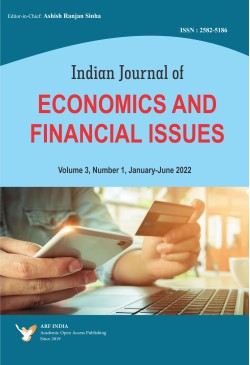
Indian Journal of Economics and Financial Issues
Frequency :Bi-Annual
ISSN :2582-5186
Peer Reviewed Journal
This paper investigates the impact of imports and exports on economic growth. To achieve this objective, ARDL Bounds Test, Vector Error-Correction (VECM) models, Dynamic OLS (DOLS), GMM, Granger Causality and Impulse Response are applied. ARDL bound test reveals the existence of long-run relationship among economic growth, export and import. The vector- error-correction model (VECM) indicates export has negative and import has positive effect on economic growth. The dynamic OLS (DOLS) results shows import has significant positive and export positive but not significant effect on economic growth. The GMM estimate indicates export has significant positive and import has negative (not significant) impact on growth. Impulse response analysis shows growth of gross state product has positive response to export shocks. Also, import has positive response to export. Overall results indicate the evidence of complementary between exports and imports implying that they play pivotal role in propelling South Carolina’s economic growth both in the short and in the long run. South Carolina development policy makers should remain pro-active in trade.
Key words: Import, Export, Economic growth, ARDL.
JEL classification codes: O10; O11; O12; O40
The paper seeks to explore the cyclical and seasonal variations for the monthly level series of US unemployment during 1948m1-2020m1 using H. P. Filter model and the ARIMA(12, 0, 12) model. The decomposition of trends and cycles was done through TSL method. The forecast ARIMA(4, 1, 4) was tested as stable model in which volatility tends to equilibrium as also was found from Impulse Response Function. The seasonality was also verified through ARIMA(12, 0, 12) where GARCH(1, 1) was seen as declining nature of conditional variance having heteroscedasticity problem.
Key words: US unemployment, seasonal unemployment, cyclical unemployment, volatility, ARIMA model, ACF, PACF.
JEL codes: C20, E24, E32, E47, J64.
This paper provides an insight into ongoing labour market reforms in India. In order to safeguard life and dignity of the workers and to align labour market policies with the requirement of changing labour market, the Government of India has laid down four Codes on labour viz; Codes on Wages; Industrial Relations; Social Security & Welfare; and Occupational Safety, Health and Working Conditions respectively, by rationalizing, amalgamating and simplifying the relevant provisions of the existing 44 central labour laws. The restructuring of the existing 44 Central Labour Acts into four major Codes is expected to reduce the complexity in its compliance, promote employment generation by enabling business environment and facilitate ease of doing business. At the same time, these initiatives are also expected to improve life and the dignity of workers by safeguarding their interest, providing social security benefits against risk, ensuring better work & working conditions, suitable and timely payment of wages and hygienic working environment. The paper also highlights challenges in implementation of some provisions of the Code and suggests modifications so that the benefits of labour market reforms can reach to both workers and employers.
Key Words: minimum wages, negotiating union, informalisation, social protection.
JEL Classification: J03, J51, J52
Progress of a country weather social or economical is largely resolute by the active contribution and participation of its labor force. Both men and women create the labor force; but it has been noted that since past decade, India has been seen a steady decline in Female Labor Force Participation (FLFP) from 37% in 2005 to an all-time low of 23 percent in 2016. On the other hand, percentage of women participation in the higher education increase. The enrolment ratio of women in higher education increased from 22% in 2012 to 26% in 2016 as per study of AISHE. The objective of this paper is to know reason behind decline in labour participation of women, as their ratio in higher education increase. The study was totally based on secondary data. This work examines the reason of women labor force participation, as against thebackdrop of India having one of the lower most participation rates for female among peer countries. The research work has revealed that in modern world women are much more creative and innovative than men. Women by nature are economical and not cause undue wastage of resources and needless expenses. If they are on condition that with the right entree backed by the right governmental strategies, they can also influence the well–being of the environment and public health at national level. The main finding is that a number of program initiatives can help in boosting female in social and economic participation in India, including labor market flexibility, speculation in infrastructure, and improved social outlay.
Keywords: Higher Education, Female labor force participation, India.
JEL Classification: H52, E24.